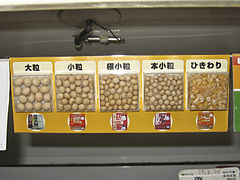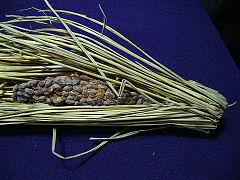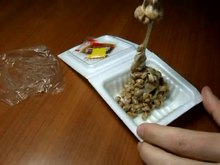Nattō
 Nattō on rice | |
| Course | Breakfast |
|---|---|
| Place of origin | Japan |
| Region or state | East Asia |
| Main ingredients | Fermented soybeans |

Nattō (納豆) is a traditional Japanese food made from soybeans that have been fermented with Bacillus subtilis var. natto.[1] It is often served as a breakfast food.[2] It is served with karashi mustard, soy or tare sauce, and sometimes Japanese bunching onion. Nattō is often considered an acquired taste because of its powerful smell, strong flavor, and sticky, slimy texture.[3][4][5][6][7] Within Japan, nattō is most popular in the eastern regions, including Kantō, Tōhoku, and Hokkaido,[8] and a 2009 survey revealed that 70.2% of Japanese people find the taste pleasant, and others who may not find the taste of the food pleasant still eat it for health benefits.
History[]
Sources differ about the earliest origin of nattō. One theory is that nattō was codeveloped in multiple locations in the distant past, since it is simple to make with ingredients and tools commonly available in Japan since ancient times.[9]
Legendary origins[]
One story about the origin of nattō attributes it to the samurai Minamoto no Yoshiie (1039–1106), who was on a campaign in northeastern Japan between 1086 AD and 1088 AD. One day, his troops were attacked while boiling soybeans for their horses. They hurriedly packed up the beans, and did not open the straw bags until a few days later, by which time the beans had fermented. The soldiers ate it anyway, and liked the taste, so they offered some to Yoshiie, who also liked the taste.[10][11]
Another story involves Prince Shotoku (574–622), who is said to have wrapped the oddments of boiling soybeans in straw bags for his horse. As people happened to eat these fermented beans and found them delicious, this type of fermented stringy beans soon gained popularity in Japan because of its unique taste and strong flavor.[12]
Chinese douchi[]
Before nattō, there was a similar dish of fermented black soybeans food in China called 豉 (chǐ) or douchi. These are salted, fermented-and-aged whole soybean seasonings or condiments invented in China and spread throughout East Asia as a merchandise. This type of food is usually made from fermented soybeans and with an ample amount of salt; however, the ingredients and producing method differ in Japan. Chinese use both black and yellow soybeans to produce douchi whereas Japanese nattō only uses yellow soybeans. The amount of salt used also makes difference between douchi and nattō on their taste and appearance.[13][14]
The cultivation method of soybeans and rice was imported from China to Japan during the Yayoi period, and later on, the circulation of salt began to flourish in Japan. This provided an opportunity for the production of douchi to become popular in Japan. Because salt was expensive and valuable at the time, it has been inferred that nattō was invented by accident during the production of douchi. [10] [12]
There was also a wooden slip excavated in Heijō-kyō, which had the Chinese character 豉 written on it.[12][13] The excavation of the slip is considered an evidence to support the hypothesis that the invention of nattō was based on the Chinese douchi imported to Japan.
The Chinese character 豉 entered Japan in the 8th century. It was pronounced "kuki" until the eleventh century, when nattō became a new name for fermented soybeans.[14]
Commercialization of nattō in the Edo period
A change in the production of nattō occurred in the Taishō period (1912–1926), when researchers discovered a way to produce a nattō starter culture containing Bacillus subtilis without the need for straw, thereby simplifying the commercial production of nattō and enabling more consistent results.[15]
Appearance and consumption[]
Nattō has a distinctive odor, somewhat akin to a pungent aged cheese. Stirring nattō produces many sticky strings.[1]
Nattō is frequently eaten as nattō gohan (nattō on rice). Nattō is occasionally used in other foods, such as nattō sushi (nattōmaki), nattō toast, in miso soup, tamagoyaki, salad, as an ingredient in okonomiyaki, chahan, or even with spaghetti. Sometimes soybeans are crushed and fermented. This is called hikiwari nattō.[citation needed]
Many find the taste unpleasant and smelly while others relish it as a delicacy. Nattō is more popular in some areas of Japan than in others. Nattō is known to be popular in the eastern Kantō region, but less popular in Kansai. A 2009 Internet survey in Japan indicated 70% of respondents like nattō and 30% do not, but about half of those who dislike nattō eat it for its health benefits.[16]
Production process[]

Nattō is made from soybeans, typically nattō soybeans. Smaller beans are preferred, as the fermentation process will be able to reach the center of the bean more easily. The beans are washed and soaked in water for 12 to 20 hours to increase their size. Next, the soybeans are steamed for six hours, although a pressure cooker may be used to reduce the time. The beans are mixed with the bacterium Bacillus subtilis, known as nattō-kin in Japanese. From this point on, care must be taken to keep the ingredients away from impurities and other bacteria. The mixture is fermented at 40 °C (104 °F) for up to 24 hours. Afterward, the nattō is cooled, then aged in a refrigerator for up to one week to allow the development of stringiness.
In nattō-making facilities, these processing steps have to be done while avoiding incidents in which soybeans are touched by workers. Even though workers use B. subtilis natto as the starting culture, which can suppress some undesired bacterial growth, workers pay extra-close attention not to introduce skin flora on to soy beans.[17]
To make nattō at home, a bacterial culture of B. subtilis is needed. B. subtilis natto is weak in lactic acid, so it is important to prevent lactic acid bacteria from breeding. Some B. subtilis natto varieties that are closer to odorless are usually less active, raising the possibility that minor germs will breed. Bacteriophages are dangerous to B. subtilis.[citation needed]
Historically, nattō was made by storing the steamed soybeans in rice straw, which naturally contains B. subtilis natto. The soybeans were packed in straw and left to ferment.[citation needed]
End product and nutrition[]
This section needs more medical references for verification or relies too heavily on primary sources. (June 2019) |

Mass-produced nattō is sold in small polystyrene containers. A typical package contains two, three, or occasionally four containers, each 40 to 50 g. One container typically complements a small bowl of rice.
Nattō has a different nutritional makeup from raw soybeans, with lower calorie content and enriched in branched chain fatty acids (BCFA), a prebiotic made by Bacillus subtilis.[18] By mass, nattō is 55% water, 18% protein, 11% fats, 5% fiber, and 5% sugars.[19] Nattō is a source of calcium, magnesium, protein, potassium, vitamins B6, B2, and E.[20] A serving of nattō (100 g) provides 29% of the Daily value (DV) of vitamin K, 22% of the DV for vitamin C, 76% of the DV for manganese, 48% of the DV for iron, and 22% of the DV for dietary fiber.[21] Nattō has softer dietary fiber without the high sodium content present in many other soy products, such as miso.
Nattō is an extremely rich source of the MK7 variant of vitamin K2, with one study finding mean concentrations of 998μg MK7 per 100g of natto, over 500 times greater concentration than any other food tested. [22]
Nattō odor comes from diacetyl and pyrazines, but if it is allowed to ferment too long, then ammonia is released.[23]
Close relatives[]

Many countries around Asia also produce similar traditional soybean foods fermented with Bacillus subtilis, such as shuǐdòuchǐ (水豆豉) of China, cheonggukjang (청국장) of Korea, tempeh of Indonesia, thuanao (ถั่วเน่า) of Thailand, kinema of Nepal and the Himalayan regions of West Bengal and Sikkim, tungrymbai of Meghalaya, hawaijaar of Manipur, bekang um of Mizoram, akhuni of Nagaland, and piak of Arunachal Pradesh, India.[8][24]
Gallery[]

A nattō bean-size legend using beans before fermentation in a supermarket

Nattō being stirred with chopsticks

Nattō gunkan maki (Nattō sushi)

Nattō wrapped in rice straw, old-style nattō package
See also[]
- Oncom – Indonesian traditional fermented dish
- Corn smut – A fungal plant disease on maize and teosint
- Fermented bean paste – Fermented foods made from ground soybeans
- Japanese cuisine – Culinary traditions of Japan – Other fermented soy foods include soy sauce, Japanese miso and fermented tofu.
- List of ancient dishes and foods – Wikipedia list article
- List of fermented soy products – Wikipedia list article
- List of soy-based foods – Wikipedia list article
References[]
| Wikimedia Commons has media related to: Natto (category) |
- ^ Jump up to: a b Hosking, Richard (1995). A Dictionary of Japanese Food - Ingredients and Culture. Tuttle. p. 106. ISBN 0-8048-2042-2.
- ^ McCloud, Tina (7 December 1992). "Natto: A Breakfast Dish That's An Acquired Taste". Daily Press. Retrieved 25 December 2012.
It is a traditional soybean breakfast food from northern Japan and it's called natto. [...] As a breakfast food, natto is usually served over steamed rice and mixed with mustard and soy sauce.
- ^ Katz, Sandor Ellix (2012). The Art of Fermentation: An In-Depth Exploration of Essential Concepts and Processes from Around the World. Chelsea Green Publish. pp. 328–329. ISBN 978-1603582865.
Natto is a Japanese soy ferment that produces a slimy, mucilaginous coating on the beans, something like okra. [...] The flavor of natto carries notes of ammonia (like some cheeses or overripe tempeh), which gets stronger as it ferments longer.
- ^ A., M. (30 March 2010). "Not the natto!". Asian Food. The Economist. Retrieved 25 December 2012.
... natto, a food that has achieved infamy among Japan's foreign residents.
- ^ Buerk, Roland (11 March 2010). "Japan opens 98th national airport in Ibaraki". BBC News. Retrieved 25 December 2012.
... natto, a fermented soy bean dish that many consider an acquired taste.
- ^ "Natto Fermented Soy Bean Recipe Ideas". Japan Centre. Retrieved 25 December 2012.
Natto are one of those classic dishes that people either love or hate. Like Marmite or blue cheese, natto has a very strong smell and intense flavour that can definitely be an acquired taste.
- ^ "Preparing Nattou". Massahiro. Retrieved 28 March 2013.
Preparing Nattou step by step, without using rice straw.
- ^ Jump up to: a b Shurtleff, W.; Aoyagi, A (2012). History of Natto and Its Relatives (1405–2012). Lafayette, California: Soyinfo Center.
- ^ Deutsch, Jonathan; Murakhver, Natalya (2012). They Eat That?: A Cultural Encyclopedia of Weird and Exotic Food from Around the World. ABC-CLIO. p. 141. ISBN 978-0-313-38058-7. Retrieved May 20, 2016.
- ^ Jump up to: a b "納豆 金のつぶ 納豆まめ知識|ミツカングループ商品・メニューサイト". webcache.googleusercontent.com. Retrieved 2019-11-07.
- ^ William Shurtleff; Akiko Aoyagi (2012). History of Natto and Its Relatives (1405–2012). Soyinfo Center. ISBN 978-1-928914-42-6.
- ^ Jump up to: a b c "起源は?発祥は?知られざる納豆の歴史 | ピントル". 納豆専門ページ | ピントル (in Japanese). Retrieved 2019-11-07.
- ^ Jump up to: a b "History of Natto and Its Relatives (1405-2012) - SoyInfo Center". www.soyinfocenter.com. Retrieved 2019-11-16.
- ^ Jump up to: a b "History of Soy Nuggets (Shih or Chi, Douchi, Hamanatto) - Page 1". www.soyinfocenter.com. Retrieved 2019-12-14.
- ^ Kubo, Y; Rooney, A. P; Tsukakoshi, Y; Nakagawa, R; Hasegawa, H; Kimura, K (2011). "Phylogenetic Analysis of Bacillus subtilis Strains Applicable to Natto (Fermented Soybean) Production". Applied and Environmental Microbiology. 77 (18): 6463–6469. doi:10.1128/AEM.00448-11. PMC 3187134. PMID 21764950.
- ^ "納豆が出来るまで。納豆の製造工程". Natto.in. 2004. Archived from the original on 2014-02-01. Retrieved 2013-09-15.
- ^ Wang DH, Yang Y, Wang Z, Lawrence P, Worobo RW, Brenna JT. High levels of branched chain fatty acids in nātto and other Asian fermented foods. Food Chem. 2019;286:428‐433. doi:10.1016/j.foodchem.2019.02.018
- ^ United States Department of Agriculture, Agricultural Research Service. National Nutrient Database for Standard Reference Release 27 Basic Report: 16113, Natto
- ^ "Natto – Nutritional Information". eLook.org. Retrieved 2013-09-15.
- ^ Natto nutritional values
- ^ Schurgers LJ, Vermeer C. Determination of phylloquinone and menaquinones in food. Effect of food matrix on circulating vitamin K concentrations. Haemostasis. 2000;30(6):298-307. doi:10.1159/000054147
- ^ Kada S, Yabusaki MY, Kaga T, Ashida H, Yoshida KI (2008). "Identification of Two Major Ammonia-Releasing Reactions Involved in Secondary Natto Fermentation" (PDF). Biosci. Biotechnol. Biochem. 72 (7): 1869–1876. doi:10.1271/bbb.80129. PMID 18603778. S2CID 30111356. Archived from the original (PDF) on 2017-12-07.
- ^ Arora, Dilip K.; Mukerji, K. G.; Marth, Elmer H., eds. (1991). Handbook of Applied Mycology Volume 3: Foods and Feeds. CRC Press. p. 332. ISBN 978-0-8247-8491-1.
- Fermented soy-based foods
- Japanese cuisine terms
- Japanese inventions
- Japanese cuisine
- Buddhist cuisine





